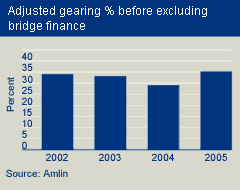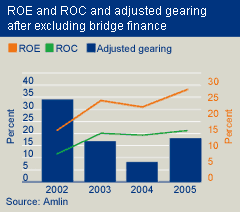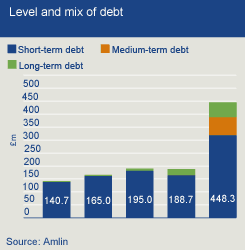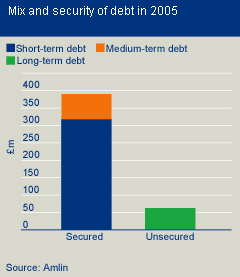Financial leverage
The underlying approach to financial leverage is simple. We believe that debt capital should be a significant part of the capital employed by the Group when underwriting margins are strong.
However leverage should reduce when underwriting margins weaken.
This philosophy is driven by the amount of underwriting risk to which we believe the balance sheet is exposed. Our underwriting strategy has cycle management at its core. If underwriting margins increase we will want to expand our business. This is particularly true of attritional classes of business (ie classes where frequency of claims is higher but the level of claims, and hence profits, is more predictable). In these circumstances, whilst our absolute underwriting risk increases, the expected absolute underwriting margin also increases and the income statement is better able to absorb the volatility from catastrophe events. The risk of financial loss is therefore lower and we employ debt capital to fund the business expansion.
The extent of financial leverage for the last four years are shown in the following chart.
 |
Notes
- Debt includes term debt, letters of credit, finance leases and bridging loan.
- Net gearing is defined as debt less cash divided by total capital.
- Cash includes free cash and undistributed accrued profit in the Lloyds premium trust fund (ptf)
- Capital is defined as shareholders' funds plus debt
- As at 31 December in each year
|
However, we believe that this overstates the real net financial leverage that the Group has carried in recent years. This is because historically the Lloyd's capital regime has given limited recognition, for solvency purposes, to profits earned in the first three years following the start of an underwriting year. These profits have effectively been 'trapped' in the Lloyd's trust funds. This is significantly different to the position for an insurance company which would recognise the profits as solvency capital as they are reported.
To the extent that Group debt is secured against these trapped profits we regard this debt as 'bridging finance' which can be quickly paid down once the profit is released from the Lloyd's system and can be then made available as solvency capital. The need for this mechanism is now reduced as Lloyd's have changed the distribution framework for 2005 and now expect to release all profits recorded under an annual accounted basis within six months of the end of the financial year.
Excluding this 'bridging finance' from the debt deployed reduces the extent of financial leverage as illustrated below.
 |
Notes
- Debt includes term debt, letters of credit, finance leases and bridging loan.
- Net gearing is defined as debt less cash divided by total capital.
- Cash includes free cash and undistributed accrued profit in the Lloyds premium trust fund (ptf)
- Capital is defined as shareholders' funds plus debt
- As at 31 December in each year
|
It is clear that the capital management strategy has enhanced shareholder returns over recent years.
It is also apparent from the chart that the level of financial leverage has increased again at the end of 2005. This is appropriate as a result of the expected hardening of insurance and reinsurance rates post the hurricane losses of 2005. Our investment of US$1 billion of capital in Bermuda, and increase of £150 million in syndicate capacity, was funded partly through a rights issue of £215 million (net of expenses), and partly through an increase in debt capital of £243 million, with the balance from internal sources.
However, the level of gearing employed at the end of 2005 is less than that employed at the end of 2001 despite generally good market conditions. This is deliberate and reflects the increased proportion of reinsurance written by the Group and also that no reinsurance is being purchased for Amlin Bermuda. These both lead to greater potential volatility which is being mitigated by lower risk from the capital structure deployed.
Type of debt employed
Historically Amlin has relied upon short term commercial bank debt. In particular Lloyd's allows the use of letters of credit ("LOCs") for solvency capital and much of the debt capital raised has been in this form.

The use of LOCs, or short term bank debt, has allowed levels of debt to be adjusted efficiently to meet the short term needs of the business, while recognising the inefficiency of the old Lloyd's system in recognising 'trapped' profits as capital. For example, to help fund Amlin Bermuda, a one year loan of £150 million was drawn, which is expected to be fully repaid out of profits distributed from Syndicate 2001 in the first six months of 2006.
FSA have now more closely defined the type of acceptable solvency capital for insurance operations in the UK. This introduces the need for higher quality, longer term debt capital in order to qualify for solvency purposes. Whilst this does not strictly apply at the moment to Amlin's Lloyd's operations we believe that this may change. Therefore, in November 2004 Amlin issued US$50 million of fifteen year subordinated debt followed by another similar issue in March 2005. Both debt issues are callable by Amlin after ten years.
The mix of debt split by maturity and security is set out below.

|